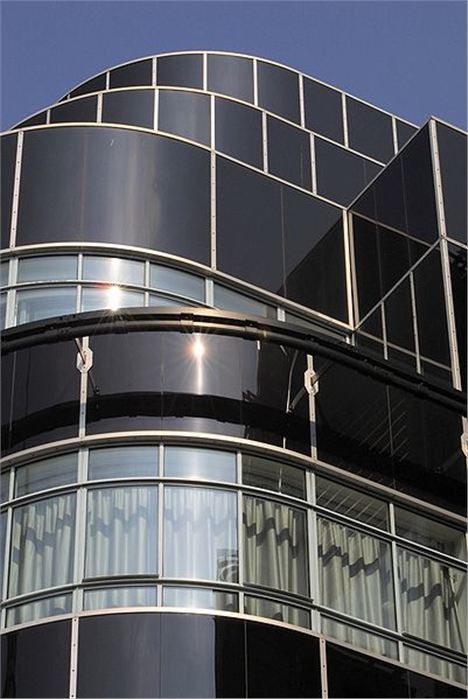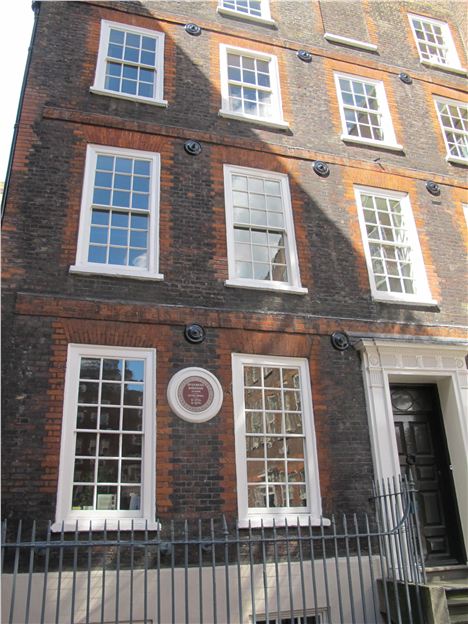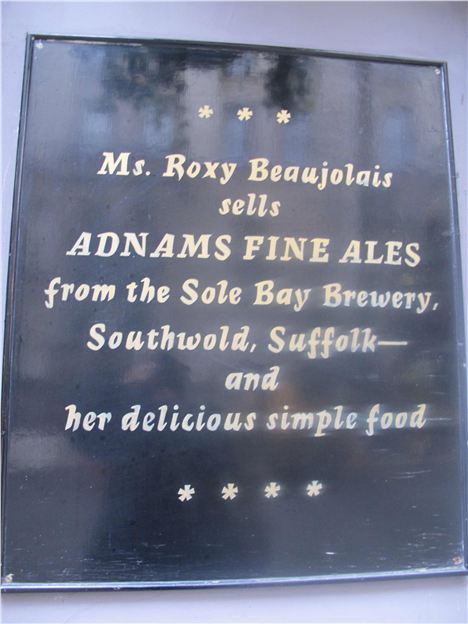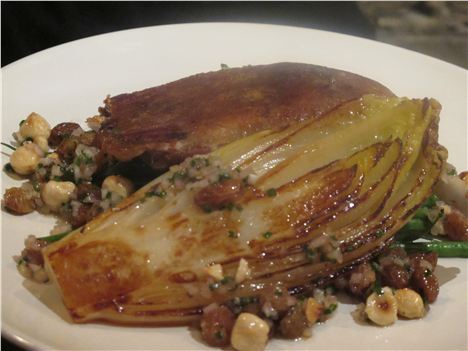Travel editor Neil Sowerby closes his three-part series on London with a return to Fleet Street, which has lost its newspaper past but is still a fascinating district that’s also handy for the best the capital has to offer.
STREET of Shame, I sweated on your deadlines. Haunted your watering holes. After dark on the publishing floor I got your printer’s ink on my forearms and in the morning in your greasy spoons I rummaged through your red-tops. Once a hack, always a hack... though I wouldn’t have got away then with any intro as flowery as this!
'Run by a legendary Aussie landlady called Roxy Beaujolais, it has a bizarre line in artefacts and decoration'
I never wore one of those homburgs, with press card in the hatband, honest, nor got to shout Hold The Front Page, but I did make it to Fleet Street in the dying throes of Lunchtime O’Booze and “legendary scoops”. Now in today’s digital age newsprint threatens to become as yesterday as cave paintings. So it was with as much trepidation as a kid reporter doorstepping the Krays that I returned to the long-abandoned heartland of the national press.
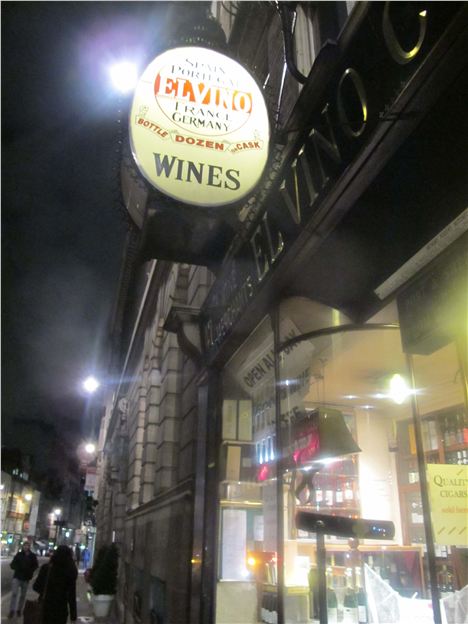 El Vino – legendary Fleet Street watering hole
El Vino – legendary Fleet Street watering hole
This time via Virgin Trains. As a weekender. Not chasing bygones, though I could have gone on a Ghosts Of Fleet Street Tour (link here) or hung round The Cheshire Cheese or El Vino to soak up (as they say) the atmosphere.
In truth, there’s scant physical evidence of the Street’s long inky past (by the 1540s the area was pumping out scurrilous pamphlets and the first agony aunt rag, The Athenian Mercury came off the presses in 1640).
En route for our hotel, the Apex Temple Court, our taxi took us past one iconic Fleet Street site, lampooned by Private Eye as the Black Lubyanka. The art deco Daily Express HQ, whose sister building in Manchester’s Ancoats looks a twin, has been adapted for new business use since the mass exodus of print barons in the 1980s. It would have made a good museum of the dark arts of Beaverbrook, Northcliffe, Maxwell... and Murdoch (whatever happened to him?)
One constant – the red buses still thunder down this classic London artery linking St Paul’s and the City with the West End and beyond, making today’s Fleet Street a very handy weekend base. Just off it lay our lodging, the latest Apex Hotel, The Temple Court. I’m a big fan of this Scottish chain, who have two other London outposts, at London Wall and near The Tower, but the new one is a step-up.
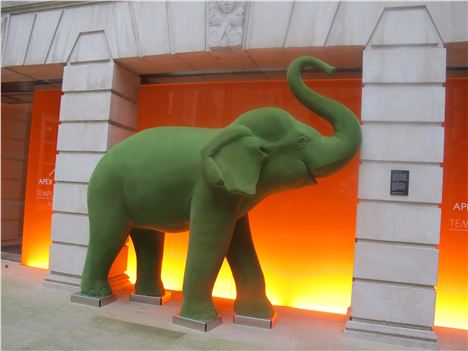 Elephant guards the lovely Apex Temple Court hotel
Elephant guards the lovely Apex Temple Court hotel
The conversion of post war office buildings, nestling among the legal complex of The Temple, cost £50m. The main entrance is via the Serjeant’s Inn Gate, where Fleet Street gives way to The Strand. An illuminated green elephant greets you in the courtyard. Inside bold textiles and red gloss walls feature, while the rooms are classic Apex design – clean lines, with satisfying textile and wood arrangements. Above all, plenty of space and amenities for business and leisure traveller alike. Breakfasts are affordable and spot on, too.
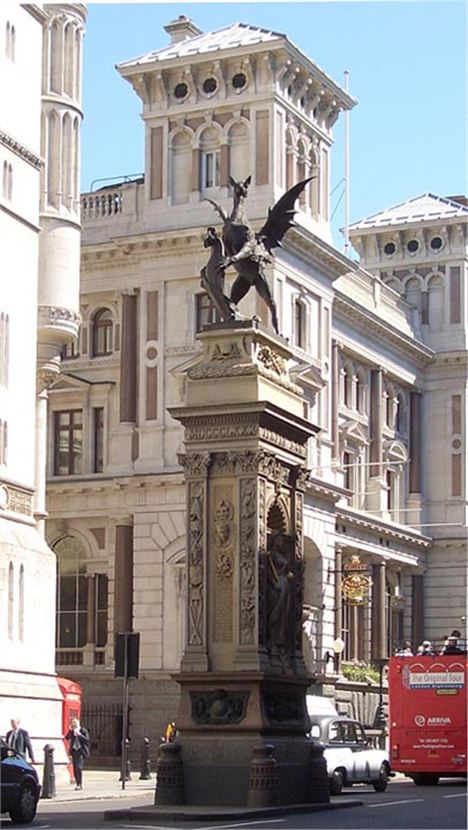 That Dragon at Temple Bar; below, the Royal Courts of Justice
That Dragon at Temple Bar; below, the Royal Courts of Justice
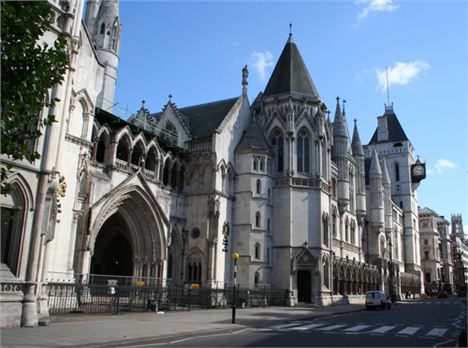 I was intrigued by the dragon-tipped Temple Bar monument outside near the Royal Courts of Justice, marking where Fleet Street becomes The Strand. The dragon only dates back to 1880; Sir Christopher Wren’s arched stone gateway that stood here before has recently been brought back and re-erected near St Paul’s. Used for regulating trade into the City, during 18th century it was used to display the heads of traitors.
I was intrigued by the dragon-tipped Temple Bar monument outside near the Royal Courts of Justice, marking where Fleet Street becomes The Strand. The dragon only dates back to 1880; Sir Christopher Wren’s arched stone gateway that stood here before has recently been brought back and re-erected near St Paul’s. Used for regulating trade into the City, during 18th century it was used to display the heads of traitors.
The last heads to be displayed were those of Towneley and Fletcher, who were taken at the Siege of Carlisle and executed in 1746. Towneley’s head was displayed on Temple Bar until a faithful family retainer secured possession and brought it back to Burnley, where for many years it was kept in a basket covered with a napkin in the drawing room at Towneley Hall.
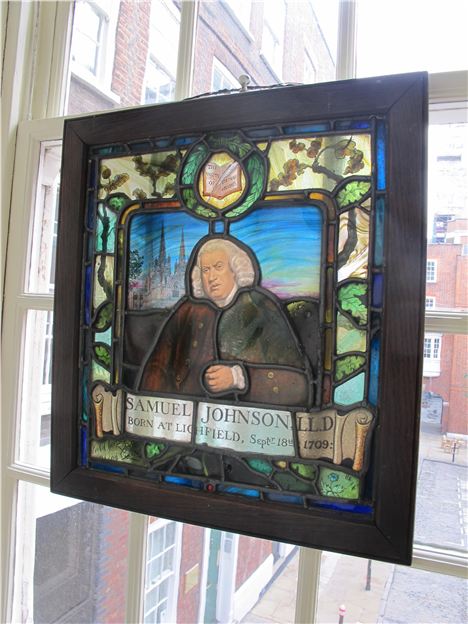 Sam immortalised in glass; below his mircaulously preserved house
Sam immortalised in glass; below his mircaulously preserved house
I’m sure Dr Johnson was familiar with all the heads. The great writer arrived in London in 1737 and presence is still palpable in this part of town – particularly at his house, tucked off Fetter Lane among some undistinguished office blocks.
The attic floor, where he once toiled over his great dictionary, was destroyed during the Blitz but the rest of the uncluttered house looks miraculously much as it must have done in the 18th century. Keeping it open is a labour love and deserves support.
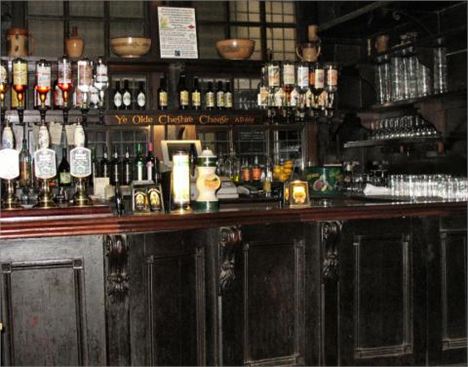 Ye Olde Cheshire Cheese is big on ye olde oake fittings
Ye Olde Cheshire Cheese is big on ye olde oake fittings
There is a discreet alleyway whisking you away to the delights of Ye Olde Cheshire Cheese. It is universally assumed the bibulous Sam frequented it, but it is never mentioned in his writings. Nevertheless the pub boasts a Dr Johnson’s chair and a portrait, as well as more quirkily, a stuffed parrot – Polly mimicked the clientele for 40 years and its death was reported across the globe. A former inn on this site, dating back to 1538, was destroyed in the Great Fire of 1666, after which the Cheese was rebuilt.
Ye Old Cheshire Cheese, 145 Fleet Street, EC4A 2BU.
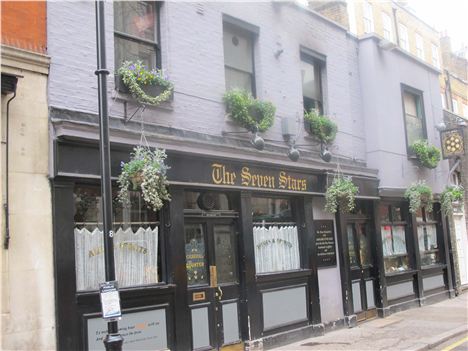 Seven Stars in Carey Street; below, Adnams Alert!
Seven Stars in Carey Street; below, Adnams Alert!
In truth I prefer another old inn on the other side of the Courts that survived the Fire of London. The Seven Stars is on Carey Street – synonymous with on Queer Street since the debtors’ courts were once on it. Run by a legendary Aussie landlady called Roxy Beaujolais, it has a bizarre line in artefacts and decoration and stocks a full range of ales from Adnams of Southwold. The Seven Stars, 53 Carey Street WC2A 2JB.
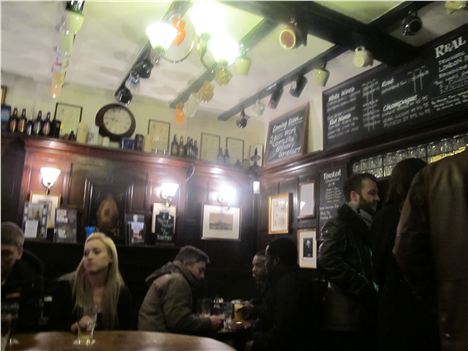 Inside that great survivor, The Old Mitre
Inside that great survivor, The Old Mitre
Another ancient hostelry (built in 1546) I knew as a journalist is the hard-to-find and snug Old Mitre, which claims the cherry tree trunk supporting the main bar was a maypole Elizabeth 1 danced around. Whatever, it is
Old Mitre, 1 Ely Court, Ely Place, Holborn EC1N 6SJ.
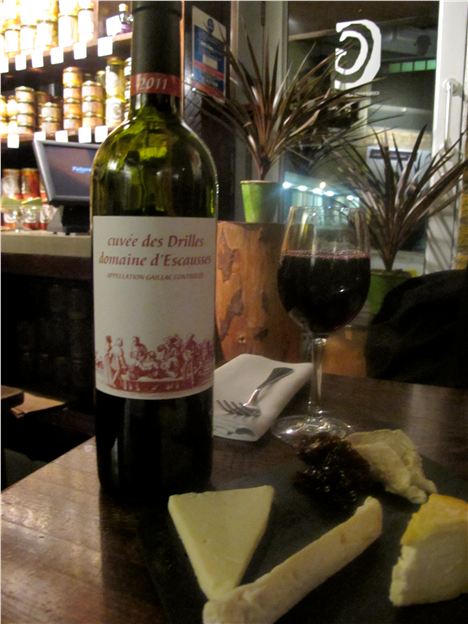 Gaillac red and beaucoup de fromage at The Comptoir Gascon
Gaillac red and beaucoup de fromage at The Comptoir Gascon
By now you are on your way to Smithfield, which has a clutch of good restaurants (Fergus Henderson’s St John’s), pubs (The Fox and Anchor) and wine bars (Vinoteca and Comptoir des Gascons, which also does delicious South Western French food).
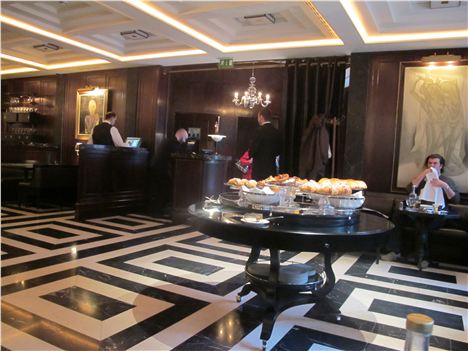 Delaunay – wonderful all-day dining and people-watching experience
Delaunay – wonderful all-day dining and people-watching experience
Our dining options, though, were all to the West off the 23 bus route, including a return visit to the wonderful Delaunay on Aldwych. Here is my ManCon review from last year click here.
Three newcomers occupied our palates gainfully during the rest of this visit:
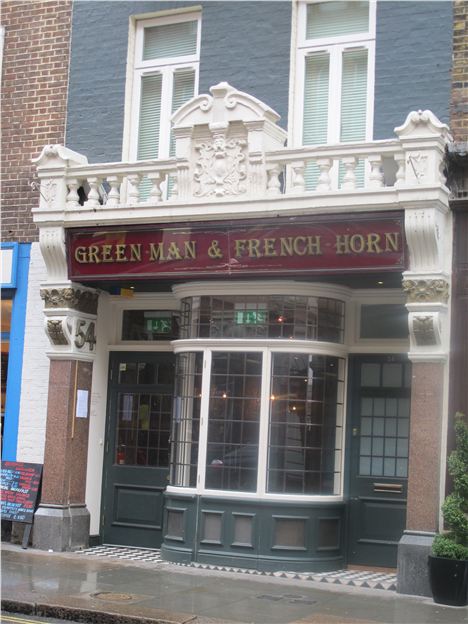 Green Man and French Horn; below confit duck with braised fennel there
Green Man and French Horn; below confit duck with braised fennel there
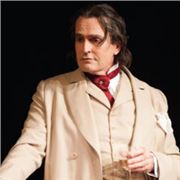 Rupert does his OscarGreen Man and French Horn
Rupert does his OscarGreen Man and French Horn
From the folk, who brought you the trendy delights of Terroirs and Brawn, this narrow, simple room specialises in the cuisine of the Loire Valley and gets it right. Less keen on the trendy “natural wines” it promotes. Our £30 Anjou cabernet france was cloudy, slightly fizzy and the fruit was unforthcoming. Still the Green Man was handily opposite the Duke of York Theatre where after a lovely lunch we saw Rupert Everett do his Oscar Wilde turn in David Hare’s The Judas Kiss. Catch it if you can, it’s immense.
54 St. Martins Lane, WC2N 4EA (0207 836 2645, greenmanfrenchorn.co).
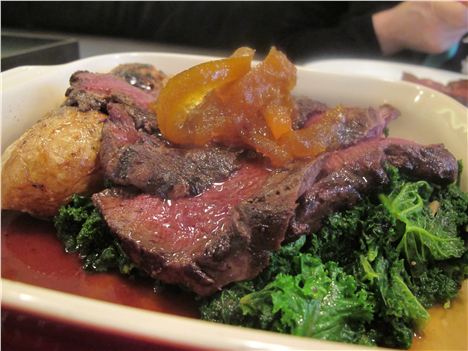 Venison haunch with jerusalem artichokes - a real power at No 10.
Venison haunch with jerusalem artichokes - a real power at No 10.
10 Greek Street
Even more basic, almost cafe like, but its food lived up to all the praise heaped upon it, notably a huge main of venison loin with kale, stoved jerusalem artichokes and caramelised seville oranges, served in its serving dish, at £40 for two to share. Wines by the third of a litre carafe, too, always a winner. 10 Greek Street, Soho W1D 4DH (020 7734 4677, www.10greekstreet.com).
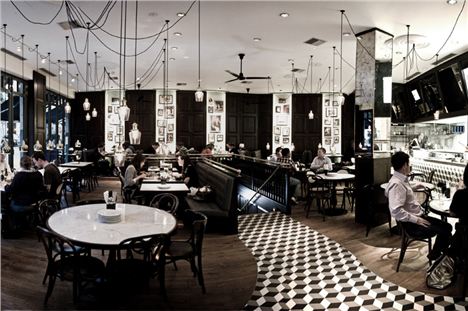 Dishhoom – big on a designer's Bombay mix
Dishhoom – big on a designer's Bombay mix
Dishoom
Attempting to recreate the now sadly vanishing Irani cafes of Bombay, Dishoom is lavish with its ceiling fans and Mumbai memorabilia, marble tabletops and black and white tiled floors. The name means the sound-effect when a Bollywood hero lands a good punch. Whihc all smacks a bit of concept-led. Punch was perhaps lacking in the deep-fried snack style food we sampled, but the place was buzzing with a young crowd. There’s also a branch in Shoreditch – naturally. 12 Upper St Martin’s Lane, WC2H 9FB (020 7420 9320, www.dishoom.com)
Buzzing was a word associated primarily with bees in Dr Johnson’s time. Recounting a visit to Fleet Street in the 1700s, Sam’s friend, the Scottish lawyer and author James Boswell wrote that the assault on his senses had left him "agreeably confused". That seems the perfect object of a weekend in London, even today.
Black and white main image of Fleet Street ©Nobuyuki Taguchi.
www.nobuyukitaguchi.com
www.photovisible.com
Fact file
Getting there:
Virgin Trains runs up to 50 trains a day between Manchester and London. For details of services and fares, including special promotions, visit www.virgintrains.co.uk. For timetable information ring National Rail Enquiries 08457 48 49 50.
Staying there:
Neil Sowerby was guest of the Apex Temple Court, 1-2 Serjeants’ Inn, Fleet St,
London EC4Y 1LL. Rooms from £178. It’s part of the Scottish-run Apex chain, which has further four-star London hotels at City of London at Tower Bridge and London Wall. Visit www.apexhotels.co.uk. London weekend discounted breaks, room only based on two adults sharing, from £119 until March 23 2013.
London tourist information: www.visitlondon.com.
Dr Johnson’s House, 17 Gough Square, EC4A 3DE, www.drjohnsonshouse.org.








